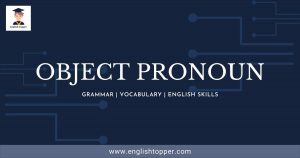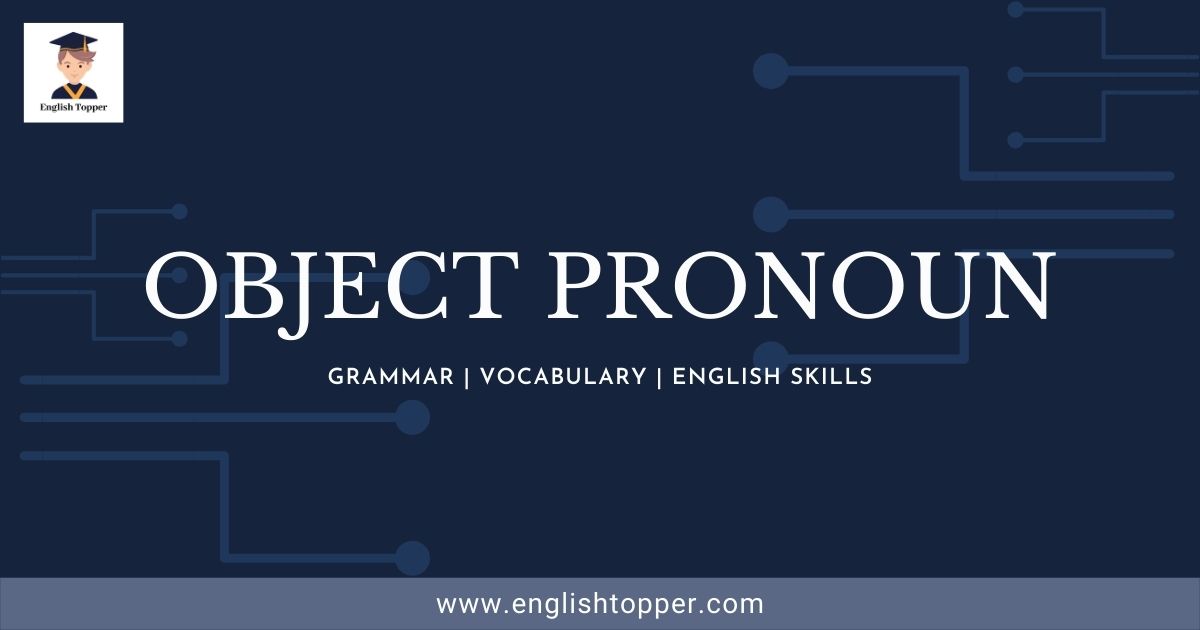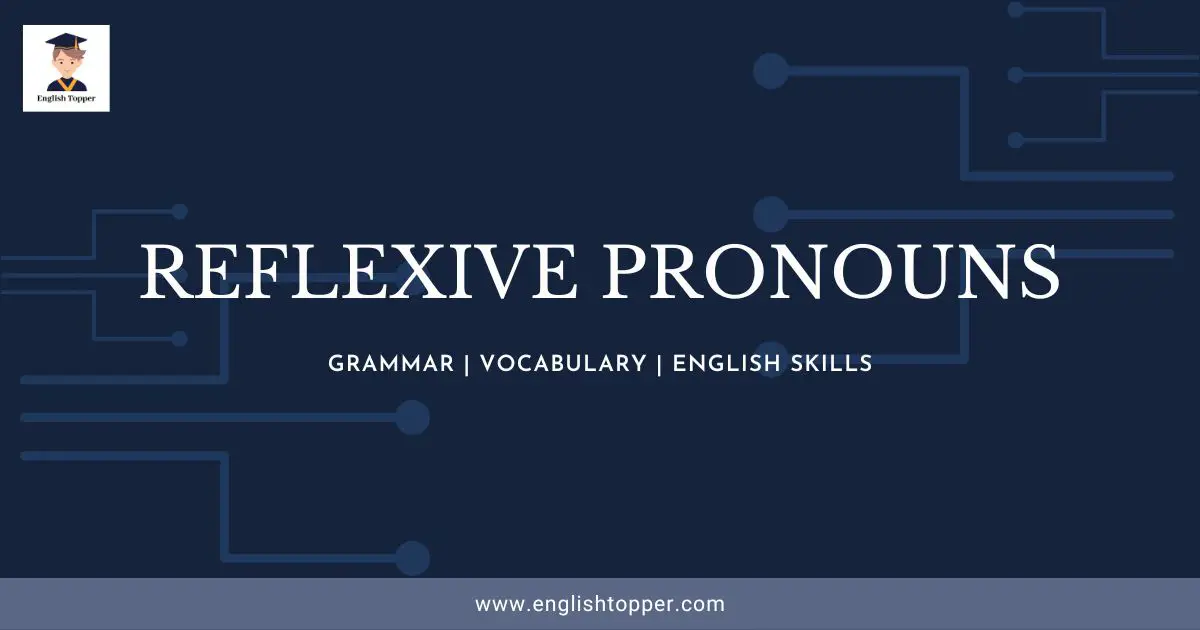Table of Contents
What is an Object Pronoun in English Grammar?
An Object Pronoun is a type of personal pronoun that receives the action in the sentence. A few examples are you, him, her, them, us, me, etc. It is also called “Objective Pronoun”.
In simple words, we can also define it as “the pronoun that is used to replace the object noun is known as Object Pronoun”.
These pronouns are often replaced by nouns that receive the action in the sentence, and thus it cannot be the subject in the sentence because these are objects which are somehow affected by the other subject in the sentence.
In other words, the object pronoun which replaces the object noun cannot be the subject of that sentence. Let us learn this concept more in detail.
We all know that, generally, a sentence contains 3 elements. Those are Subject, Verb and Object (SVO). We also know that Pronouns are used to replace nouns in sentences.
Here, we should only focus on the object of the sentence. Let us consider an example.
Example Sentence: Raju ate chocolate.
Here, the sentence is divided as Raju (Subject) + ate (Verb) + chocolate (Object).
Since according to the sentence structure, the word “Raju” is called Subject Noun and “chocolate” is called Object Noun.
Suppose if we used the pronoun “it” in place of “chocolate”, then the sentence will be,
Sentence with Object Pronoun: Raju ate it.
So, the word “it” is called an object pronoun.
Example Sentence: I like to talk to Mary. (Here, “Mary” is the noun object)
Sentence with Object Pronoun: I like to talk to her. (Here, “her” is the pronoun object)
The below table consists of 7 different types of objective pronouns.
| Subject Pronoun | Object Pronoun |
| I | Me |
| You | You |
| He | Him |
| She | Her |
| It | It |
| We | Us |
| They | Them |
Note: Here, in Object Pronoun, the pronoun “You” is used for both Singular and Plural forms.
References:
Personal Pronoun | (Definition & Examples) | Full Guide 2021
What is a Sentence in English Grammar? | Best Guide for 2021
Types of Personal Objective Pronoun
The personal pronoun which is used as direct object, indirect object or as an object of a preposition is known as Personal Objective Pronoun. There are three types of it which are mentioned below.
- Direct Object
- Indirect Object
- Object of a Preposition
Direct Object
The direct object of a sentence is a thing that is being acted by the verb. An example is mentioned below.
Example Sentence: I know him.
Here, the sentence structure is: I (subject) + know (verb) + him (direct object).
We can observe that the action (verb) is implied/acted on the pronoun (him).
Indirect Object
The indirect object of a sentence is a thing that is a recipient of a direct object.
In simple words, the verb is directly affecting on the direct object and indirectly affects the pronoun, which makes it an indirect object. An example is mentioned below.
Example Sentence: I sent her a gift.
Here, the sentence structure is: I (subject) + sent (verb) + her (indirect object) + a gift (direct object).
We can observe that the action (verb) is implied/acted on the direct object (a gift), but the pronoun (her) became the indirect object because it is a recipient of the direct object.
Object of a Preposition
The Object of a Preposition is defined as an object pronoun that is being controlled by the preposition in a sentence.
Example Sentence: He was with us.
Here, the sentence structure is: He (subject) + was (verb) + with (preposition) + us (object pronoun).
We can observe that the preposition (with) is used in between the verb (was) and object pronoun (us).
More examples of Object Pronoun
Here are some more examples for a better understanding of this topic.
- Object Noun: John likes to dance in front of audience.
- Object Pronoun: John likes to dance in front of them.
- Object Noun: The teacher congratulated Sam in the class.
- Object Pronoun: The teacher congratulated him in the class.
- Object Noun: We had fun playing old classic games.
- Object Pronoun: We had fun playing it.
- Object Noun: Mr. Carlson wants to talk to Micheal.
- Object Pronoun: Mr. Carlson wants to talk to him.
- Object Noun: I gave my textbook to Sara.
- Object Pronoun: I gave my textbook to her.
- Object Noun: The company is going to give everyone a bonus this weekend.
- Object Pronoun: The company is going to give us a bonus this weekend.
- Object Noun: Shaun likes to invite you for his birthday party. (“You” is in Singular form)
- Object Pronoun: Shaun likes to invite you for his birthday party.
- Object Noun: It was a great surprise seeing you all. (“You” is in Plural form)
- Object Pronoun: It was a great surprise seeing you all.
- Object Noun: I am excited to watch a film tonight.
- Object Pronoun: I am excited to watch it tonight.
- Object Noun: The football match was splendid. We really liked the match.
- Object Pronoun: The football match was splendid. We really liked it.
Usage of Object Pronoun
Object Pronouns can be used in many ways. Some of them are mentioned below.
- It can be used for the object of a verb. (Direct Object)
Example Sentences:
- I did it!
- The team played it very well.
- He respects them.
- She won it.
- Siri knows him.
- It can be used after a preposition (Object of a Preposition).
Example Sentences:
- It’s important to me.
- He works for them.
- The cake for us.
- Jenny told something to them.
- She is suspicious to us.
- It can be used after ‘be’ (mostly used in informal language).
Example Sentences:
- It is him!
- Oh! It’s you again!
- Likewise, it is her.
- It was her!
- Who’s there? It’s me!
- It can be used after ‘as’ and ‘than’ for comparison.
Example Sentences:
- He is as smart as her.
- He is smarter than her.
- She rides as fast as them.
- She rides faster than them.
- It can be used after ‘but’ and ‘except’.
Example Sentences:
- Everyone lost the game but me.
- Everyone lost the game except me.
- The teacher scold everyone but me.
- The teacher scold everyone except me.
How to identify Object Pronoun in any sentence?
Below are a few simple steps to follow in order to find the Object Pronoun in the sentence. To explain this, we will choose an example sentence.
The basic structure of the object pronoun is,
Subject (Noun/Pronoun) + Verb + Object Pronoun + Object
Example Sentence: The teacher gave us a lot of homework.
Step 1: Identify the structure of the given sentence. That is SVO (Subject Verb Object).
i) So, the first task is to identify the Subject in the sentence. Here, the Subject is “teacher”
The teacher gave us a lot of homework.
ii) Next, identify the verb (action) in the sentence. Here, the verb is “gave”.
The teacher gave us a lot of homework.
iii) Then, finally, identify the object that receives the action (verb)/gets influenced by the subject in the sentence.
Tip: Mostly, the object pronoun will be positioned after the verb.
The teacher gave us a lot of homework.
Here, we got the final answer, which is “us”. But make sure that it is in the form of the pronoun, otherwise, it is called an Object Noun if it is in the noun form.
Quiz (Test Your Knowledge)
#1. Identify the proper Object Pronoun for "John" in the sentence, "Kate made a cake for John".
#2. Identify the Objective Pronoun for "my school" from the given sentence, "I like my school very much".
Answer: “it” is the Object Pronoun for “my school”.
#3. Where are my keys? I can't find ___ .
Answer: it
#4. "She loves children very much". Identify the correct Object Pronoun for the Object Noun (children)
Answer: “them” is the correct pronoun for “children”.
#5. "I am new to this city. Can you guide ___ to this place?" Choose the correct option.
Answer: me
#6. "I bought him a car". Identify the Indirect Object from the sentence.
Answer: “him” is the Indirect Object.
Explanation: Here the verb is affected by the direct object (car) and indirectly affects the indirect object, which is “him”.
Structure: I (subject) bought (verb) him (indirect object) a car (direct object).
#7. "I am happy that you all made the event more exciting than ever!". Identify the Object Pronoun.
Answer: you
#8. "This exercise is very easy. I can do ___." Choose the correct option.
Answer: it
#9. "My friends made a surprise for me for my birthday party." Identify the type of Personal Objective Pronoun of the sentence.
Answer: Object of a preposition
Explanation: The given sentence has the pronoun (me) which is being controlled by the preposition (for).
#10. "She teaches them physics in school". Choose the right object pronoun.
Answer: them
Results
|
Getting your Trinity Audio player ready...
|
Hurray….. You have passed this test! 🙂
Congratulations on completing the quiz. We are happy that you have understood this topic very well.
If you want to try again, you can start this quiz by refreshing the page.
Otherwise, you can visit the next topic 🙂
|
Getting your Trinity Audio player ready...
|
Oh, sorry about that. You didn’t pass this test! 🙁
Please read the topic carefully and try again.
Summary: (What is an Object Pronoun in English Grammar?)

Here is the summary of what we had learned till now.
- Object Pronoun is a type of pronoun which is located at the object region in the sentence. It majorly consists of seven different objective pronouns. That is him, her, it, you, us and them.
- There are three different types of objective personal pronouns. Those are Direct, Indirect and Object of a Preposition.
- In order to identify it in the sentence, first, you need to identify three things. That is Subject, Verb and Object.
- Often it will be located either near to the verb or preposition in the sentence.
- It can also be used for formal and informal types of sentences.
- These type of pronouns are mainly used to replace the object noun of the sentence.
If you are interested to learn more about this topic, then you can refer to Wikipedia from here.
Thank you for reading this article. If you have any doubts regarding this topic, then you can simply comment down below, and we will be responding to your doubts as soon as possible. Please don’t forget to share this with your family and friends.







